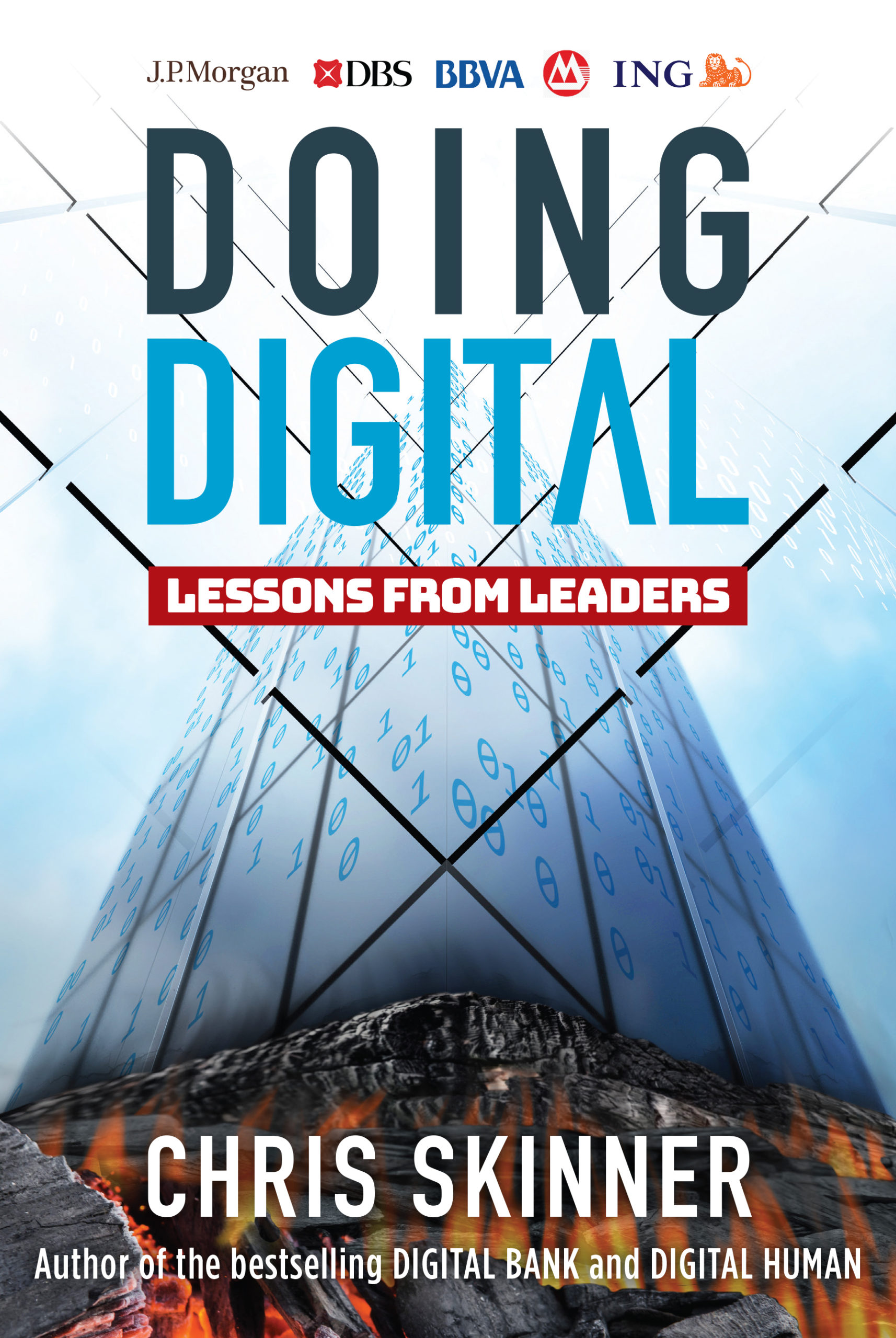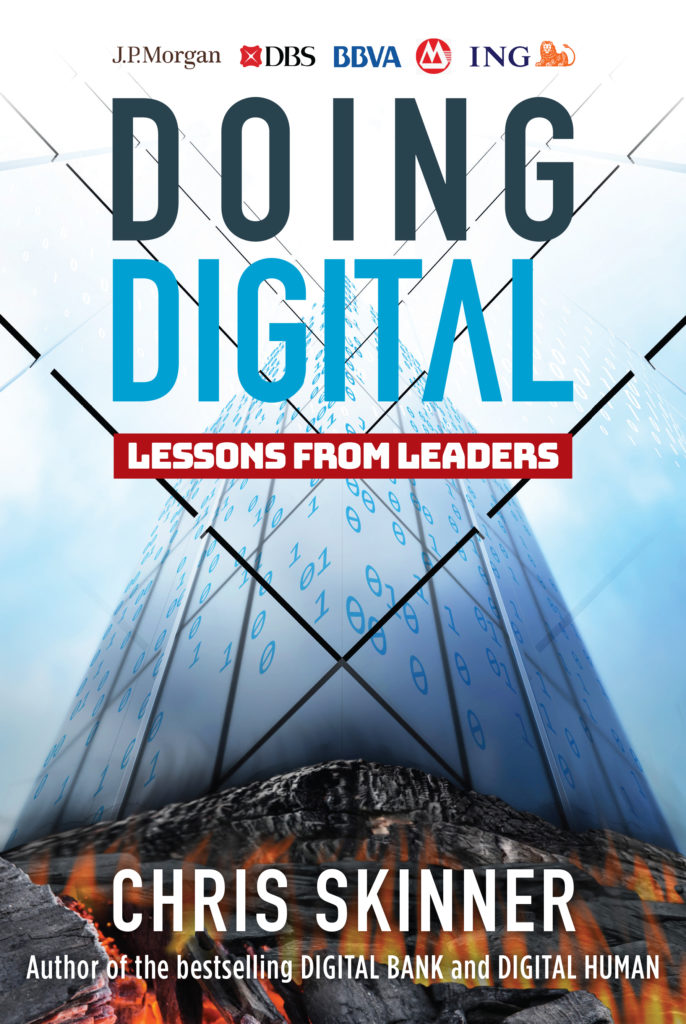With this one, I took it one step further and actually wrote down a list of the biggest banks I thought were doing digital transformation well back in 2018. I then made contact with those banks and asked if they would participate as research participants for the new book and share their experiences of doing digital transformation. The fact that I got a yes from all five banks I approached – BBVA, China Merchants Bank, DBS, ING and JPMorgan Chase – says something.
In fact, I was quite gratified that when seeking endorsements for the new book, Anthony Thomson (founder and former chairman Metro Bank and atom bank, co-founder and chairman 86 400, Australia’s first bank for mobile) made the comment: “only Chris could get some of the world’s largest digital banker leaders to talk so openly and honestly about the challenges and opportunities facing them.” That kind of sums up this new book well, in that it combines transparency of dialogue with five of the biggest banks in the world and the lessons they have learned doing digital transformation, along with my own perspectives and experiences over a lifetime of delivering technology transformation to financial institutions.
You visited the five banks personally, what added insights and value does it bring by including face to face interactions when researching for a book?
Great question Simon, as I’m advocating doing everything digitally, so why meet physically? However, there’s a big difference in creating relationships if you have physical interaction. Sure, I have many digital relationships, where I’ve never met those people physically. You’re one of them. But getting a totally open and honest dialogue with someone who doesn’t know me from the get-go is really hard if you don’t have a direct interaction. In fact, most of my digital circle of friends and peers have been formed through years of sharing interactions over social media.
I don’t think any of them would feel like good buddies if I was seeing their first tweet or LinkedIn update today. It takes a long time to gain digital trust. Physical trust can be achieved far faster if you have a face to face interaction. That’s the reason why I never see branches disappearing. First and foremost, branches provide trust in the institution that you can go there and see someone. Second, it provides trust that if my money is being held digitally, I can still eyeball a human if I get nervous.
Think back to any financial crisis and what’s the first thing people do? Queue outside the branch to get their money. But it’s more than this. When it comes to relationships, if you don’t have a chance to deal directly with a human, it creates a chasm. For example, we think of Facebook, Amazon and Google as being threats to banking, but what’s the helpline number of these companies?
Where do you go if Facebook deletes your memories to get them back online again? That’s where the physical presence makes a difference, whether it’s doing research to get open and honest lessons shared about doing digital transformation or handing over your lifetime savings to an institution.
The banks in your case study are among the most progressive and proactive at the ‘fin’ end of the fin-tech environment. At the same time you are clear in your articulation that they still face a massive challenge to get their digital transformation right and fast. Question, how are they managing so far, and how many of them do you think will succeed?
Another great question Simon. Reason being is that my editor told me off when I sent the draft in for the new book, as I qualified towards the end that I wasn’t endorsing these banks as doing digital transformation well. In fact, they are all at different stages of implementation and progress, with DBS and ING being maybe the furthest ahead.
That’s because DBS and ING have had leadership for over a decade doing digital banking as a technology first strategy in many different countries and markets. DBS are digital first in India and Indonesia; ING is digital first in many countries through ING Direct. These banks really understand digital. Even then, they struggle with it. The struggle is nothing to do with the technology however. It’s to do with the organisation, structure, management, people and culture. That’s really what the new book is all about: how to transform the people. It’s got little to do with technology per se.
Corona virus presents a massive challenge, but in some ways could hasten the progression of online payments and digital delivery of financial services. Looking in the future, might we look back at this period as a significant catalyst for further fintech evolution and changes in how we do business?
Everyone is talking about this being a moment to switch to a cashless, cardless society. Just use contactless, urges the World Health Organisation. So, this might move us faster to a less cash, less card society, but the contactless piece amuses me because often when I use contactless, the terminal asks me for my PIN. And how many people have touched those keys on the PIN pad before me? In fact, that’s more likely to spread the virus than using cash.
What we really need is for the world to move to mobile payments and facial recognition, like the payment services being rolled out in China. With Alipay today, I can just Smile-to-Pay. That’s not a concept. It’s a reality. We need that to be the future, and get rid of touch pads and dirty paper.
How can people find out more about you personally & your work?
Follow me on twitter – Chris_Skinner – and sign up for my daily nudge on email via finansernextjs.wpengine.com. I also have a few other domains – thefintechguy.com and the-troublemaker.com. You get the idea.
Where can people buy your book & how / where will you be promoting it?
The book is on all good online stores, such as Amazon, and we had a plan for a massive American promotional tour in April. That may or may not happen now, as the pandemic is affecting all markets attitudes towards meetings and events but, either way, there will be a number of promotional moments. Watch this space.
Anything else you’d like to add / we should have asked?
Not really. I think we covered most of what I’d talk about, although there’s one thing we alluded to that maybe I should expand further. The inspiration for the new book came from the fact that I’m fed up with people being bank bashers. So many commentators are saying that banks are dead, disrupted and destroyed by technologies and technology start-ups. It’s absolute rubbish. Banks are challenged by these things, but they’re not going away. They’re adapting and developing to absorb these changes.
That’s what the new book clearly demonstrates and anyone who says banks are dead meat probably need to go back to their school books and check why banks exist the way they do, why they’re regulated they way they are and how integral they are to governments and economies. There’s far more to banking than a branch with cash in it.



